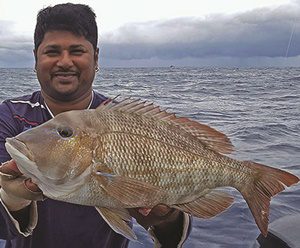
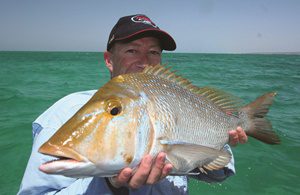
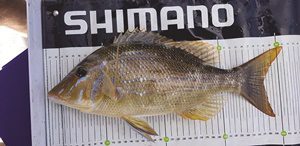
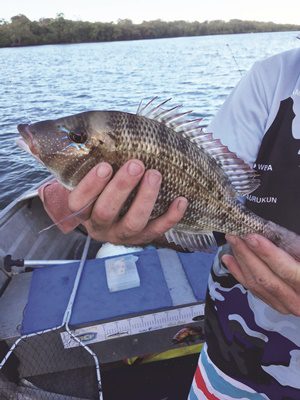
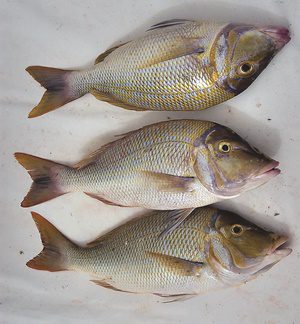
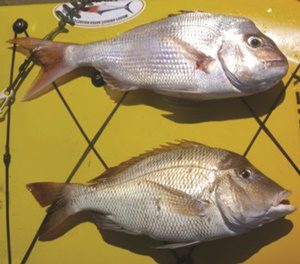
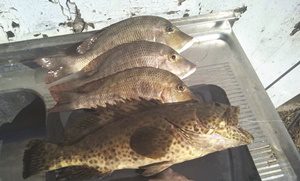
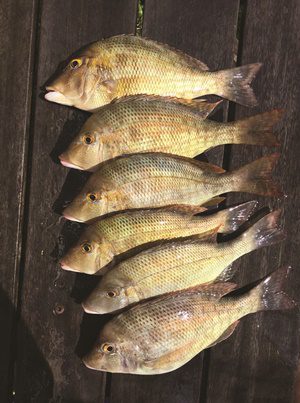
FISHING around the shallow reefs of Moreton Bay will probably see two types of sweetlip turn up.
The grass sweetlip (minimum size 30cm, max possession of 10) and spangled emperor (minimum 45cm, max possession five) are some of the tastiest fish getting around. They are also some of the best fighting fish you’ll encounter for the size. Grassies inhabit the same sort of areas as juvenile snapper and bream, while spangles are in deeper waters and only in certain areas of the bay with good drop-offs. I like to target grassies on a rising tide in 3-8m of water, while for spangles I like water of 10m-plus.
I use a variety of baits to target both species, with small plastics ideal for the grassies and small live bait for spangles. Both can be targeted with either plastics or bait. If bait is your choice and you are up in the shallows then berley is a must. You’ll draw in other species such as squire and bream and on most trips you’re likely to attract a goldspotted cod. Small whole squid and squid strips would be my first choice, then small green prawns, and they’re both attracted to strips of mullet or a side of slimy mackerel.
I use a two-hook snelled rig for both. In very shallow water I don’t use a sinker, which allows the bait to drift slowly down through the water column.
For plastics, bait profiles and paddle tail designs in the 2”-3” size range in watermelon or grey/white colours are effective. If the current is not allowing your bait to get down, just use a small sinker and a 1/8 oz jig head with the plastic. When deeper and chasing spangles, 2”-3” jerks shads and 3” Berkley Gulp Crazy Legs have worked on occasion. When a sweetlip comes onto your bait or plastic, the bite is very subtle. They will rarely belt your bait.
Use a slow retrieve with your plastics. Both rods I use for grassies have 10-12lb braid with 20lb leader. Not going too heavy will allow your smaller plastics a better action. When targeting spangles I have a rod equipped with 30lb braid and 20kg leader. As you’re targeting the drop-offs, that’s the first place they will head to. The waters in Moreton Bay are mostly fairly shallow and what we’re looking for is rubble patches, bommies and other good-looking structure.
The best bite times for both fish are dusk and dawn. When the sun rises higher it pays to move a little deeper and cast back into the shallows with a slow jerking retrieve. The productive shallow areas in the bay include Mud Island, Green Island and the shallows around the northern end of Peel Island. I have also on occasion caught grassies on the eastern side of Coochiemudlo Island. One of the better places is the Wellington Point drop-off running from the leads out of Manly down towards Raby Bay.
During the peak bite times of dawn and dusk most hits come on the drop, so plastics won’t even make it to the bottom. When retrieving plastics from the shallows I use a jerking motion to imitate an injured fish. For spangles, you can catch the odd one on the eastern side of Mud, along the Wellington Point drop-off and around Peel and Harry Atkinson Artificial Reef, but the two best places are the drop-offs from Myora up the inside of the Rainbow Channel and the drops-offs from Curtin Artificial Reef up to Bulwer.
Moreton Bay is filled with gravel patches, reefy structure and the odd bommie and all will hold fish and bait during different parts of the day and tide. I have tried a few blades but haven’t had much success with them as yet. By-catch when targeting sweetlip includes squire, cod and tuskies. Soft plastics are great shallow reef lures.
This is especially true with snapper, which love eating the lure on the drop. Sweetlip however prefer the lure on the bottom, so once the plastic touches down, hop it a few times before retrieving it. When retrieving the plastic from the bottom we use a jerk, jerk and pause action, then wind a few metres. Pause and free spool the line back a couple of metres. Keep repeating this back to the boat.
Sweetlip will often follow the lure up off the bottom and then hit it as it comes back to them. When fishing the shallows it’s important to minimise noise such as banging on the hull and excess anchor noise. We will usually drift across structure because anchoring is a sure way to turn fish off. Slow drifts are best and we have definitely done better on sweetlip when there is less run.
So grab your spin gear and head out to the shallows, especially during the dawn and dusk periods, and have some fun chasing a few sweeties.
 Bush 'n Beach Fishing Magazine Location reports & tips for fishing, boating, camping, kayaking, 4WDing in Queensland and Northern NSW
Bush 'n Beach Fishing Magazine Location reports & tips for fishing, boating, camping, kayaking, 4WDing in Queensland and Northern NSW








